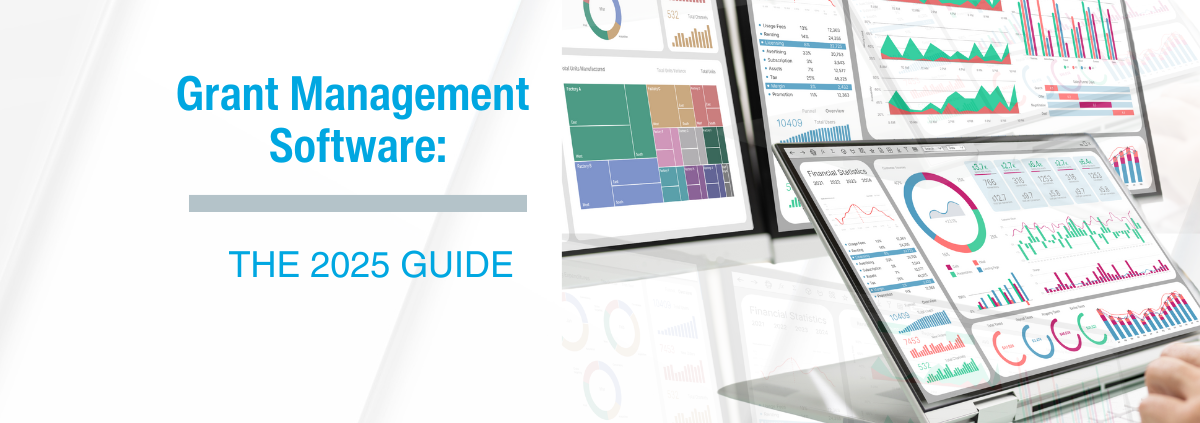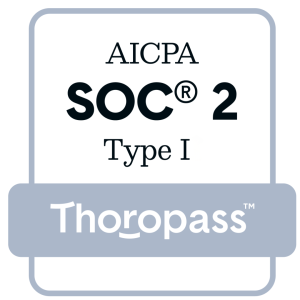How to Choose the Best Grant Management Software 2025
Table of Contents
- Introduction
- Why Choosing the Right Grant Software Matters
- Overview of the 2025 Grant Software Landscape
- Key Considerations When Selecting Grant Software
- Top Features to Look for in Grant Software
- Best Practices for Evaluation and Selection
- Emerging Trends in Grant Software
- FAQs
- Top Grant Software Options for Nonprofits
- How Does Grant Software Improve Efficiency?
- How Does It Improve Compliance Tracking?
- Choosing a Grant Software Vendor That Aligns with Your Mission
Introduction
Grants are competitive, timelines are tight, and expectations are sky-high. Whether you’re a local authority, nonprofit, or funding body, managing grants in 2025 isn’t just about keeping things organised — it’s about staying ahead. That’s where the right grant software comes in.
But with so many platforms out there, how do you choose one that fits your process — not the other way around? In this guide, we break down what to look for, what to avoid, and how to make a confident, future-ready decision.
Why Choosing the Right Grant Software Matters
The right grant software can change everything. From managing applications to ensuring compliance — your tech stack directly impacts your funding success.
In 2025, grants are more competitive than ever. The processes are more complex. Deadlines are tighter. Funders expect real-time data and transparency. You need tools that keep up.
Modern software lets you track, submit, and report seamlessly. It reduces errors. It saves time. And it frees your team to focus on building stronger proposals — not wrestling with spreadsheets.
When integrated with your internal systems, it becomes a single source of truth. That’s how you stay ahead.
“Before Submit.com, reviewing confidential information and managing applications securely was a real challenge. The manual process was cumbersome and time-consuming. The transition to Submit brought us a secure, customizable platform that made collaboration and reporting much easier.”
— Dr. Hannon, The Katharine Howard Foundation
Read the full story
In today’s funding landscape, the right software isn’t optional — it’s essential.
Overview of the Grant Software Landscape in 2025
The grant software landscape in 2025 is more dynamic, intelligent, and secure than ever before. New technologies are shaping the way public sector bodies, nonprofits, and funders manage grantmaking — from application intake to post-award reporting.
Today’s platforms are increasingly powered by automation, cloud infrastructure, and artificial intelligence. These tools help grant managers process data faster, extract predictive insights, and customize workflows to their specific needs. Many systems now integrate with financial software and CRM tools — reducing duplication and supporting end-to-end funding visibility.
Remote accessibility is no longer a nice-to-have — it’s a must. Cloud-based grant software has become the norm, allowing distributed teams to collaborate securely from anywhere. With data protection regulations tightening globally, built-in compliance and audit tracking features are also seeing a major surge in demand.
Trends show a shift toward strategic tools — not just operational ones. Grant managers are increasingly seeking software that enables faster reporting, better collaboration, and more alignment with long-term impact goals.*
With so many evolving options on the market, 2025 offers organizations an opportunity to modernize — and future-proof — their grant processes with platforms that are smart, secure, and scalable.
*Research conducted by Submit.com’s internal team
Key Considerations When Selecting Grant Software
Assessing Your Organization’s Needs
Before diving into software comparisons, take a step back. Understanding your organization’s needs is the most important part of making the right decision.
Start by mapping your current grant processes. Are you missing deadlines? Struggling with reporting? Losing track of applications? These are signs your current tools aren’t working.
Think about scale: How many grants do you manage per year? Are they simple or complex? The more volume and variables you handle, the more robust your system needs to be — especially in areas like accounting, compliance, and data tracking.
Also consider your team’s tech confidence. Do you need training-heavy onboarding or a plug-and-play interface? Knowing this will help you assess UI/UX needs and user roles.
Most importantly, get input from across your organization. Finance, compliance, grant writers, and reviewers all have different pain points. Bringing them to the table gives you a full view of your requirements.
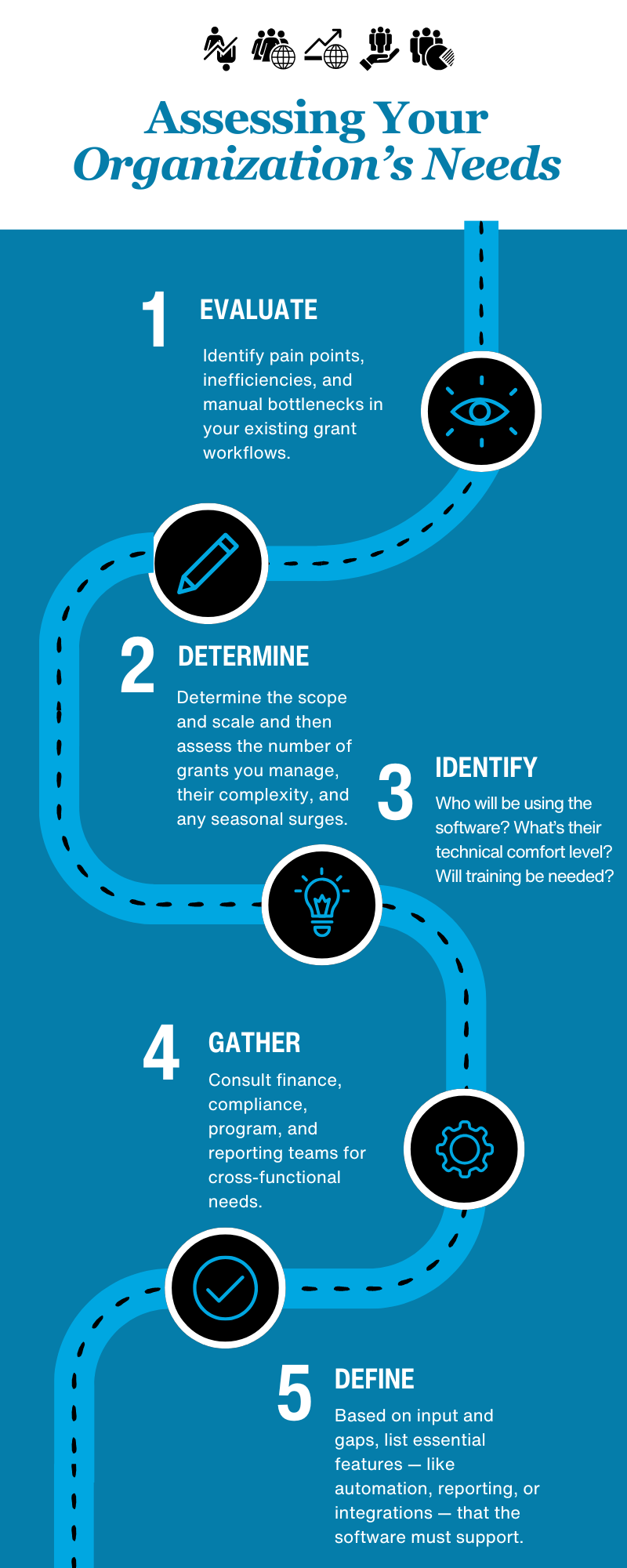
When you know what’s broken, you’ll know exactly what to fix.
Defining Budget Constraints and Pricing Options
Understanding your organization’s budget constraints is essential when selecting grant management software. Start by outlining your available budget—consider both initial costs and ongoing expenses like subscription fees, maintenance, and support services. A clear financial overview ensures you make informed choices without compromising on necessary features or functionality related to the grants lifecycle.
When exploring pricing options, you’ll find that most grant management software is available through subscription models. These often come with tiered pricing based on features, user volume, or data capacity. For instance, grant management software pricing can vary, with options ranging from free versions to those costing up to $3,500 annually, depending on the vendor and package requirements. Assess whether a basic or premium package aligns better with your needs and budget. It’s also important to account for potential additional costs, such as customization, integration with current systems, and training for your team.
Comparing different software solutions allows you to identify the best value for your money. Some vendors offer discounts for nonprofits or multi-year commitments, which can be advantageous for stretched budgets. With so many options available, it’s important to evaluate these solutions based on specific criteria that align with your needs and goals. Take the time to request demos and ask vendors about flexible payment plans or trials to test the software’s suitability.
“The hardest part is finding the right balance between what you are spending and the benefits a grants management software can bring to your organization.”
— Optimy Blog
Read the full article
Evaluating Essential Features and Functionality
The right features are the ones that solve your real problems — not the ones that just look good on a checklist.
Look for tools that improve day-to-day workflows: automated application tracking, customizable intake forms, built-in reporting, and audit trails. These features directly support compliance, speed, and accuracy — all critical for managing modern grant programs.
Integration is key. Make sure your chosen platform can connect with existing systems like CRMs, accounting tools, or document management software. This ensures your team spends less time copying data and more time making impact-driven decisions.
Also consider collaboration features — shared dashboards, reviewer assignments, and real-time commenting can dramatically improve your internal efficiency, especially across departments.
Finally, don’t underestimate the value of scalability. Choose a platform that can grow with your programs, adapt to new funding streams, and stay compliant with evolving grant standards.
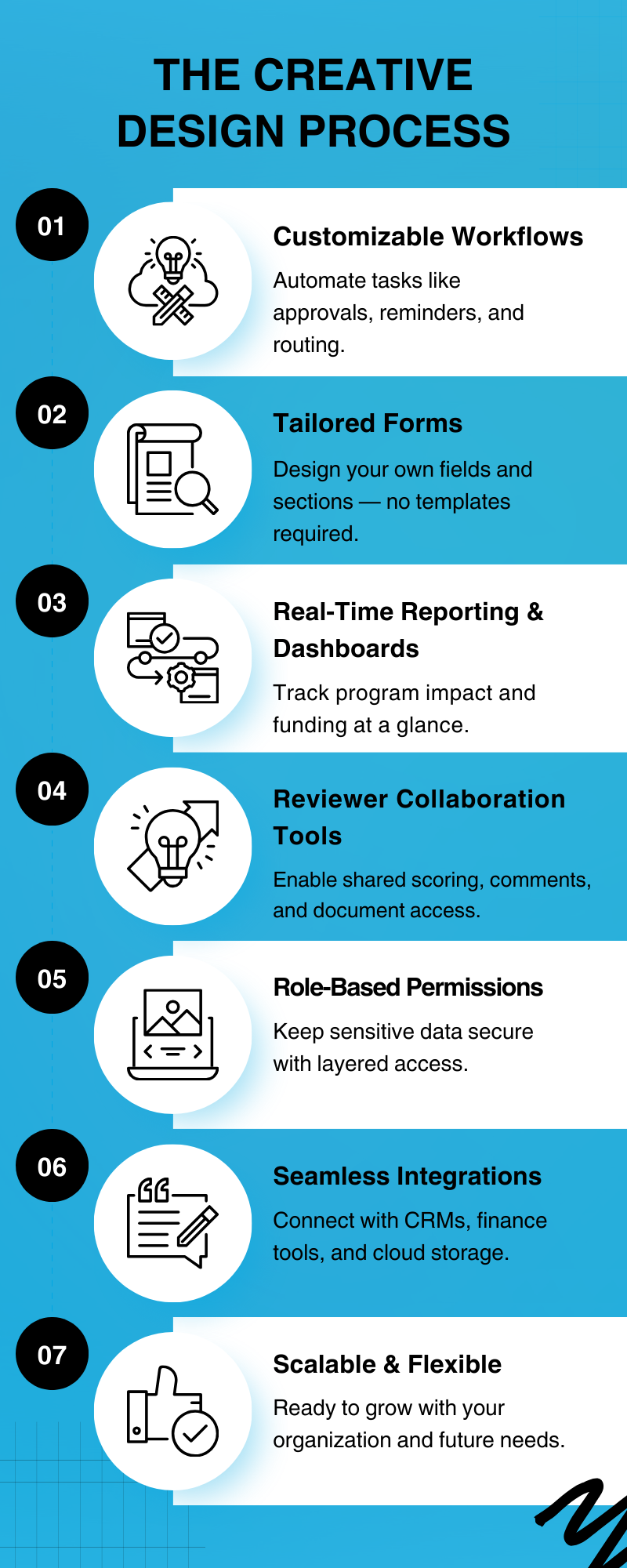
Importance of Compliance and Security
In grant management, compliance and security aren’t just checkboxes — they’re critical to your credibility and operations.
As organizations handle sensitive financial and personal data, staying compliant with regulations like GDPR or HIPAA is a must. Choose software that evolves with the legal landscape, offering built-in tools for automatic compliance updates, audit logs, and user access controls.
Security is just as crucial. Prioritize platforms that offer robust encryption, two-factor authentication, and secure cloud storage. These features help safeguard your data — and your reputation — from breaches or accidental loss.
And don’t overlook data integrity. You need clean audit trails, permission logs, and export-ready reports that stand up to scrutiny from funders, auditors, and internal reviewers.
In 2025, the City of Portland’s Office of Community & Civic Life came under public scrutiny after an audit revealed persistent grantee non-compliance and communication breakdowns. Without a formal system to track performance and intervene early, they were unable to enforce accountability or recover misused funds — ultimately eroding trust in the grant process.
Read the full case report
Must-have features for a secure, compliant grant system:
| ✔ Feature | Why It Matters |
|---|---|
| Data Encryption | Protects sensitive information in transit and at rest from unauthorized access. |
| Two-Factor Authentication (2FA) | Adds a second layer of security for user login and access. |
| GDPR / HIPAA Compliance | Ensures data handling meets legal standards and protects user rights. |
| Role-Based Access Controls | Limits access to only those who need it — and nothing more. |
| Audit Trails | Creates a timestamped log of every action for accountability and transparency. |
| Automatic Security Updates | Keeps the platform protected against evolving digital threats. |
| Secure Cloud Hosting | Backed by certifications (e.g., ISO, SOC 2) to ensure infrastructure safety. |
Bottom line? The right software should help you meet compliance goals automatically — and make you audit-ready at all times.
User-Friendly Interface and Ease of Use
A user-friendly interface isn’t just a nice-to-have — it’s essential for team productivity and adoption. The easier your grant software is to use, the faster your team can focus on what matters: securing funding and making an impact.
An intuitive design means less time training and more time doing. Look for tools that offer a clean layout, drag-and-drop functionality, and clearly labeled navigation. These features reduce errors, improve speed, and make life easier for users of all technical skill levels.
Accessibility matters too. The software should be usable on desktop, tablet, or mobile — wherever your team works. Support resources like tutorials, guides, and onboarding tips should be built right in.
Want to see this in action? Here’s a quick walkthrough showing how Submit keeps things simple, fast, and user-focused:
Bottom line: If your team dreads logging in, it’s not the right tool. Choose software that empowers — not overwhelms.
Automation and Workflow Management
Manual grant processes don’t scale — but automation does. The right tools help you eliminate repetitive admin work and keep your entire team aligned through smart, trackable workflows.
Here’s how automation and workflow management enhance your grant operations:
- ✔ Auto-reminders: Trigger deadline notifications, status updates, and review tasks without manual tracking.
- ✔ Smart data entry: Pre-fill common fields, auto-validate forms, and reduce duplication errors.
- ✔ Approval routing: Set up review hierarchies and auto-assign submissions based on rules.
- ✔ Task dependencies: Ensure the right steps happen in sequence — automatically.
- ✔ Workflow visualization: Map and edit your process using drag-and-drop tools or visual editors.
- ✔ Real-time collaboration: Notify team members of actions, comments, or delays instantly.
Implementing these features leads to faster decision-making, fewer errors, and less burnout for busy teams.
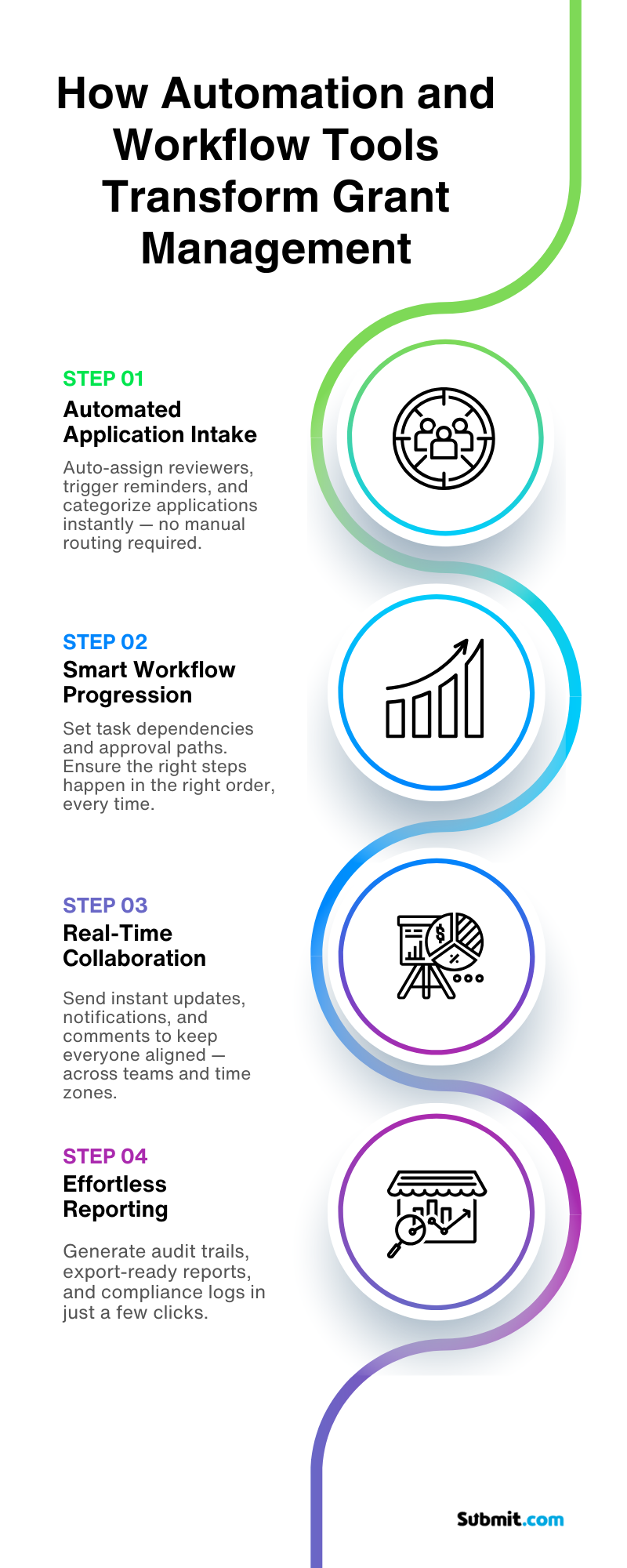
Integrated Reporting and Analytics Tools
Integrated reporting and analytics tools are a cornerstone of effective grant software, providing insights essential for decision-making and strategic planning. These tools enable you to generate comprehensive reports that cover various aspects of grant management, from financial tracking to compliance with funder requirements. By integrating these features with your donor management solution, you can leverage a centralized donor database to enrich your understanding of funding flows and donor data patterns. This integration can significantly enhance both grantmaking success and your nonprofit’s overall fundraising strategy.
With robust analytics, you can assess grant performance by examining key performance indicators (KPIs), monitor funding utilization, and identify bottlenecks or areas for improvement. Data visualization features, such as charts and graphs, make it easy to understand complex data sets at a glance. This not only enhances internal reporting but also allows for more compelling presentations to stakeholders and funders, demonstrating the impact and reach of grants. The ability to customize reports helps tailor outputs to specific needs or audiences, whether showing detailed financial data for auditors or summarizing outcomes for board presentations.
Real-time analytics and dashboards provide an ongoing view of key metrics, enabling proactive rather than reactive management. This immediacy in data handling supports quick adjustments and agile responses to any potential issues.
Compare how traditional methods stack up against integrated reporting:
| Traditional Grant Management | Modern, Integrated Analytics |
|---|---|
| Manual spreadsheets for reporting | Auto-generated dashboards & real-time KPIs |
| Static, one-size-fits-all reports | Customizable, audience-specific report formats |
| Difficult to track funding flow or grant impact | Visual performance insights with data-driven impact storytelling |
| Reactive adjustments to issues | Proactive decision-making via live alerts |
| No integration with donor databases | Unified view of grants + fundraising via CRM sync |
| Data silos across departments | Centralized analytics everyone can access securely |
By carefully managing grants with integrated reporting tools and utilizing advanced fundraising software, nonprofits can meet funder requirements effectively, paving the way for successful partnerships.
Customizable Dashboards and Alerts
A customizable dashboard in grant software allows users to tailor their interface to prioritize the most relevant information for their roles and responsibilities. This personalization ensures that each team member can access the data and tools they need quickly and efficiently, improving task management and grant oversight.
Submit.com offers powerful dashboard and alert features that adapt to your organization’s unique needs:
| Customization Feature | How Submit Supports It |
|---|---|
| Role-Based Dashboards | Each user sees a tailored view — program managers, finance teams, and reviewers only see what’s relevant to them. |
| Live KPI Tracking | Configure dashboards to display application volumes, approval rates, timelines, and funding allocation in real time. |
| Custom Widgets | Drag-and-drop interface to highlight the most important reports, charts, and action lists on your personal dashboard. |
| Smart Alerts & Notifications | Trigger automated reminders for deadlines, incomplete tasks, or document approvals based on user role and program stage. |
| Adaptive Layouts | Dashboards resize automatically for mobile, tablet, and desktop — ideal for hybrid teams or field-based users. |
| Custom Workflow Stages | Admins can design stages and approvals directly from the dashboard to reflect real-world grant lifecycles. |
Alerts play a crucial role in this dynamic setup by providing timely notifications about critical activities, such as approaching submission deadlines or changes in grant regulations. Automated alerts reduce the risk of missing significant updates or duties, ensuring your team stays ahead of key tasks.
Bottom line: Submit’s customization capabilities give every user a clear, focused, and responsive workspace — whether they’re approving budgets, scoring applications, or preparing reports.
Best Practices for Evaluation and Selection
Trial Runs: Testing Software Capabilities
Conducting trial runs is a crucial step when evaluating grant software capabilities. A trial period, or demo, lets you explore the software’s features firsthand, helping you determine whether it meets your organization’s needs.
During this phase, engage a cross-section of your team to participate in testing various functionalities. This will provide diverse insights into user experience, ease of navigation, and overall utility.
Pay attention to how the software handles essential tasks such as data entry, report generation, and integration with existing systems. Evaluate the software’s performance under realistic conditions to see if it can support your organization’s volume of data and complexity of operations.
Additionally, trial runs are an excellent opportunity to assess any support resources offered, such as tutorials or customer service, which can be pivotal for onboarding and long-term use.
Encourage feedback from your team to gather multiple perspectives on usability, functionality, and any potential challenges they encounter. This holistic approach during the trial phase ensures that when you commit, you have thoroughly vetted the software’s ability to enhance your grant management processes.
| What to Evaluate | Why It Matters |
|---|---|
| Navigation & Interface | Is the software intuitive and easy for all team members to use? |
| Data Entry & Import | Can you enter and migrate data without errors or friction? |
| Report Generation | Are reports easy to generate and customize for stakeholders? |
| Workflow Management | Can the tool support your real-world approval stages and team structures? |
| Integration with Current Tools | Does it connect with your CRM, accounting, or document systems? |
| Support & Training Resources | Are help guides, tutorials, or onboarding support easily available? |
| Performance Under Load | Does the system stay responsive with high application volumes or large data uploads? |
Comparing Customer Support and Training Options
When selecting grant software, comparing customer support and training options is essential for successful implementation and long-term usage.
Excellent customer support can make all the difference. It smooths the transition, resolves hiccups quickly, and gives your team confidence. Look for vendors that offer multiple support channels — like phone, email, and live chat — so help is always within reach when you need it most.
Next, evaluate the availability and quality of training resources. At a minimum, onboarding should include detailed user guides, video tutorials, and live training sessions. These tools help familiarize your team with the software’s capabilities — and the better they understand it, the more value you’ll get out of it.
Some vendors go a step further and offer personalized training, tailored to your organization’s specific needs. These custom sessions can dramatically boost user confidence and reduce the learning curve — especially in complex or multi-role setups.
Also consider the long-term view. Does the vendor provide ongoing support and updates? Do they actively collect user feedback and use it to improve their platform?
Good customer support isn’t just reactive — it’s proactive. You want a team that keeps you informed about changes, system updates, or potential disruptions before they become a problem.
“This was particularly challenging because different committee members may apply for a grant on behalf of an organisation in different years. The committee members often register with separate email addresses and don’t always spell the name of their organisation in the same way!”
— Ronan Herron, Digital Strategy Officer, Dún Laoghaire-Rathdown County Council
User reviews and testimonials are great tools for insight. They can reveal whether a vendor’s support team is fast, friendly, and actually helpful — or just ticking boxes. Don’t skip this research — it’s a critical part of picking the right partner.
Best Practices for Evaluation and Selection
Trial Runs: Testing Software Capabilities
Conducting trial runs is a crucial step when evaluating grant software capabilities. A trial period, or demo, lets you explore the software’s features firsthand, helping you determine whether it meets your organization’s needs.
During this phase, engage a cross-section of your team to participate in testing various functionalities. This will provide diverse insights into user experience, ease of navigation, and overall utility.
Pay close attention to how the software handles essential tasks such as data entry, report generation, and integration with existing systems. Evaluate the software’s performance under realistic conditions to see if it can support your organization’s volume of data and complexity of operations.
Additionally, trial runs are an excellent opportunity to assess any support resources offered — such as tutorials, documentation, or customer service — which can be pivotal for onboarding and long-term use.
Encourage feedback from your team to gather multiple perspectives on usability, functionality, and any potential challenges they encounter. This holistic approach during the trial phase ensures that when you commit, you’ve thoroughly vetted the software’s ability to enhance your grant management processes.
| What to Evaluate | Why It Matters |
|---|---|
| Navigation & Interface | Is the software intuitive and easy for all team members to use? |
| Data Entry & Import | Can you enter and migrate data without errors or friction? |
| Report Generation | Are reports easy to generate and customize for stakeholders? |
| Workflow Management | Can the tool support your real-world approval stages and team structures? |
| Integration with Current Tools | Does it connect with your CRM, accounting, or document systems? |
| Support & Training Resources | Are help guides, tutorials, or onboarding support easily available? |
| Performance Under Load | Does the system stay responsive with high application volumes or large data uploads? |
Comparing Customer Support and Training Options
When selecting grant software, comparing customer support and training options is essential for successful implementation and long-term usage.
Excellent customer support can significantly ease the transition to new software, providing prompt solutions to any technical issues or queries. Look for vendors that offer multiple support channels, such as phone, email, and live chat, to ensure you have access to help whenever you need it.
Evaluate the availability and quality of training resources provided. Comprehensive onboarding should include detailed user guides, video tutorials, and live training sessions to familiarize your team with the software’s features and capabilities.
Some vendors go further by offering personalized training sessions tailored to your organization’s specific needs — this can dramatically enhance team confidence and user success across departments.
Additionally, check if the vendor offers ongoing support and regular updates. It’s also worth understanding how they collect user feedback and turn that feedback into product improvements.
Customer support should not be reactive only — proactive communication is key. Regular updates, clear alerts, and readiness to help before an issue becomes urgent can have a big impact on daily operations.
“I would highly recommend Submit to anyone who needs a submission management system. As we transform our application workflows in DLR we are still finding new uses for it.”
— Ronan Herron, Digital Strategy Officer, Dún Laoghaire-Rathdown County Council
User reviews and testimonials can offer valuable insight into the real-world experience of others. They help reveal how reliable and supportive a vendor truly is — which, at the end of the day, is just as important as the software itself.
Checking User Testimonials and Reviews
Reading user testimonials and reviews provides invaluable insights when choosing grant software. These firsthand accounts offer a glimpse into the experiences of other organizations, revealing strengths, weaknesses, and nuanced aspects that might not be evident in sales pitches or product descriptions.
Pay attention to recurring themes in reviews — like ease of use, reliability, and customer support — to better gauge the software’s overall effectiveness and user satisfaction.
User testimonials can shed light on specific benefits or challenges encountered across different types of organizations. Look for feedback from organizations similar in size and scope to yours, as their experiences will likely mirror your potential usage.
While glowing reviews are helpful, don’t ignore the negative ones. Consistent issues related to speed, features, or support may indicate real gaps. That said, also evaluate how vendors respond to criticism — a proactive, transparent support culture is a great sign.
To get a well-rounded perspective, explore review platforms beyond the vendor’s own site. One trusted platform we recommend is:
👉 Submit.com on G2 – Read Real Reviews
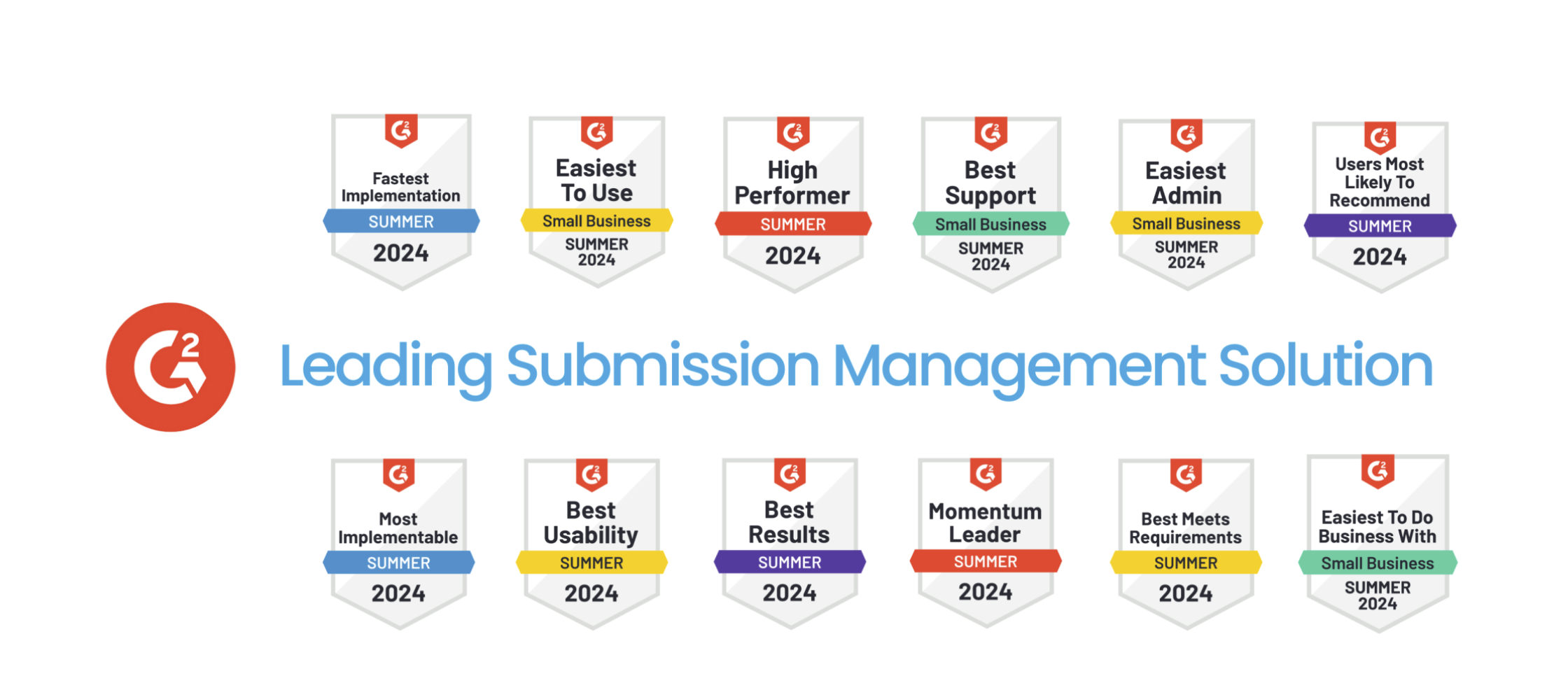
Cross-checking reviews helps you make a confident, informed choice — based on real-world results, not just marketing claims.
Analyzing Return on Investment (ROI)
Analyzing the return on investment (ROI) is a critical component when selecting grant software. This involves assessing how the software will impact your organization’s efficiency, costs, and ability to secure funding over time.
Begin by calculating the total cost of ownership — including license fees, training expenses, and ongoing maintenance costs. Then, compare those against both the tangible and intangible benefits the software brings to the table.
Consider how the platform can streamline processes and reduce overheads, leading to savings in time, labor, and manual effort. Efficient grant management software minimizes administrative burdens and allows your team to shift focus toward strategic work like proposal development and funder engagement.
Evaluate whether these efficiencies translate into measurable financial outcomes — such as improved grant success rates, faster disbursements, or reduced staff hours spent per application cycle.
Also factor in the potential for better compliance. Reducing errors, meeting deadlines, and maintaining audit-ready records all help lower the risk of lost funding or penalties — and that’s a return worth counting.
Analytics and reporting also drive long-term ROI. Tools that support data-driven decisions help create stronger grant applications and track outcomes that matter to funders.
Whenever possible, look for case studies, industry benchmarks, or testimonials from similar organizations. These can help you estimate potential gains more accurately based on real-world use cases.
A comprehensive ROI analysis ensures your investment in grant software supports both short-term wins and long-term goals. It’s about choosing a solution that doesn’t just cost less — but delivers more.
| Category | Year 1 | Year 2 | Year 3 |
|---|---|---|---|
| Total Cost of Ownership | €9,500 | €6,000 | €6,000 |
| – Software Licensing | €4,000 | €4,000 | €4,000 |
| – Training & Onboarding | €2,000 | – | – |
| – Ongoing Support & Maintenance | €1,500 | €1,500 | €1,500 |
| Estimated Financial Benefits | €12,000 | €18,000 | €22,000 |
| – Time Savings (Staff Hours) | €5,000 | €7,000 | €8,000 |
| – Reduced Compliance Penalties | €2,000 | €3,000 | €4,000 |
| – Increased Grant Success Rate | €5,000 | €8,000 | €10,000 |
This table is a hypothetical example based on common nonprofit use cases and internal estimates. Actual ROI will vary depending on organization size, application volume, staffing, and external factors.
Emerging Trends in 2025: Integration with AI and Machine Learning
As technology evolves, AI and machine learning integration is becoming a defining feature in modern grant software.
These intelligent systems enhance performance by delivering advanced analytics, automation, and smarter decision-making. AI can analyze massive datasets at speed, uncover patterns, and provide predictive insights — such as identifying likely funding opportunities and forecasting success rates based on historical performance.
Machine learning adapts over time, learning from your team’s data inputs to recommend optimal workflows, flag bottlenecks, and continuously improve operational efficiency. This results in faster grant writing, cleaner processes, and fewer repetitive errors.
Smart features also improve the user experience. Dashboards and alerts become more personalized, with AI tailoring what users see based on behavior, preferences, or role-based activity.
Compliance is another area where AI shines. These tools can automatically scan applications for missing fields, inconsistencies, or errors — flagging issues before submission and helping reduce costly mistakes.
Nonprofits and grantmakers are increasingly combining multiple specialized software tools—such as grant management platforms, donor CRMs, fundraising software for nonprofits, and accounting systems—to create smaller, more efficient tech stacks tailored to their unique workflows. This integrated approach reduces data silos, streamlines operations, and allows organizations to leverage best-in-class functionalities without the overhead of bulky, all-in-one systems.
Ultimately, AI and ML shift grant management from reactive to proactive. You’re not just tracking performance — you’re predicting it. This level of adaptability and foresight gives your organization a stronger chance at winning more grants, reducing risk, and optimizing every stage of the grant lifecycle.
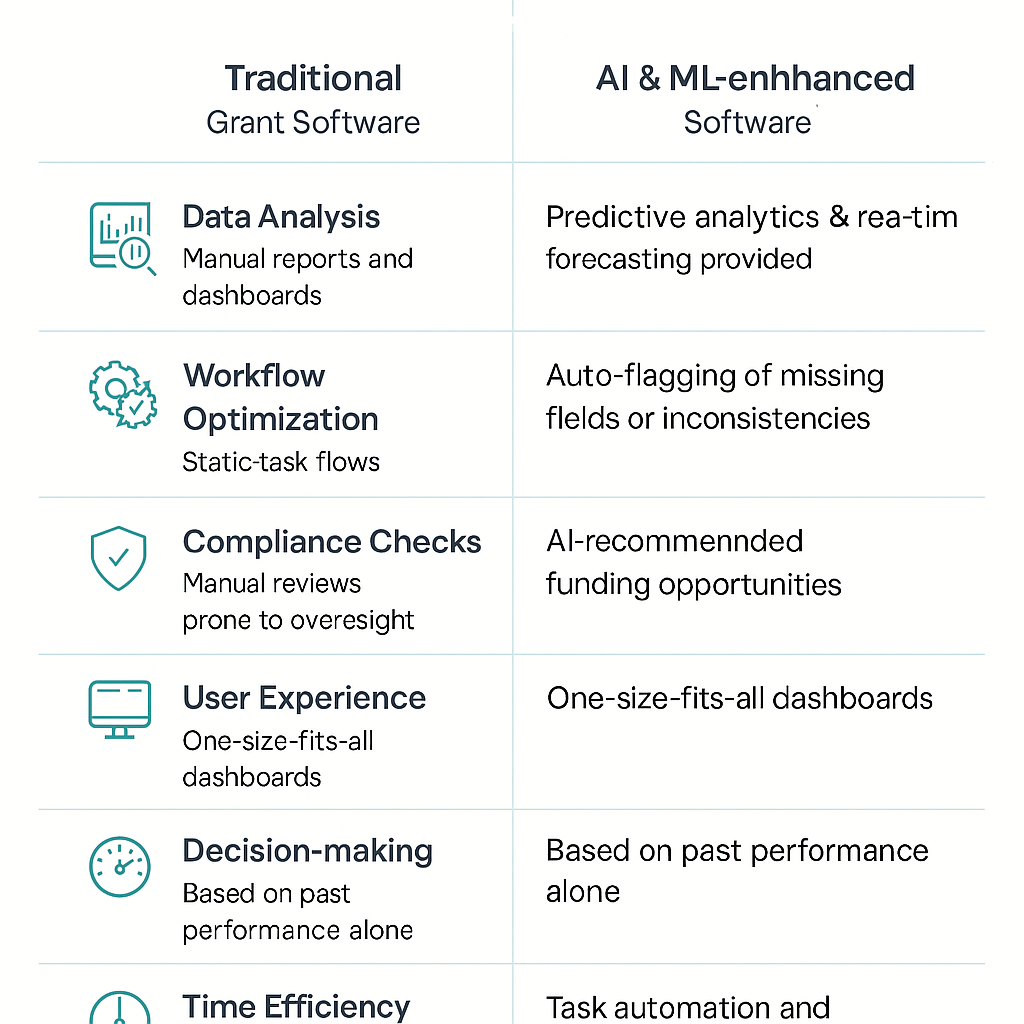
Cloud-Based Solutions for Remote Management
In an increasingly digital world, cloud-based solutions are indispensable for effective grant management, particularly with the rise in remote work. These solutions offer unparalleled flexibility, allowing your team to access the software from anywhere, at any time, using any device with an internet connection. This capability ensures continuity of operations regardless of geographical constraints or access to office resources.
Security is a major advantage of cloud-based systems, as they typically offer high-level data protection protocols like encryption and secure access controls, safeguarding sensitive grant information. Many cloud providers also handle regular updates and maintenance, reducing the burden on your IT department and ensuring your software stays up-to-date with the latest features and security enhancements.
Moreover, cloud-based solutions facilitate real-time collaboration among team members, enabling seamless communication and task management. Shared dashboards, document repositories, and instant updates keep everyone aligned and informed, fostering an interconnected work environment despite physical distances.
Choosing a cloud-based grant management solution also supports scalability. As your organization grows, the cloud can easily accommodate increasing data volume and user additions without necessitating complex infrastructure changes.
Enhanced Collaboration Features
Enhanced collaboration features in grant software are essential for fostering teamwork and improving communication among stakeholders, especially in a diverse and geographically dispersed environment. These features enable seamless interactions, whether your team is working remotely or in-office, ensuring all members have real-time access to the same information and updates.
A robust collaboration module might include shared workspaces where team members can work on documents simultaneously, reducing version control issues and enhancing productivity. Commenting and feedback tools allow for immediate input on proposals and reports, streamlining revisions and approvals. Integrated messaging systems can replace cumbersome email threads, facilitating direct communication within the context of specific tasks or projects.
Project management features, such as task assignments and deadline tracking, help ensure that everyone understands their responsibilities and timelines. This creates accountability and keeps projects on track while enabling managers to easily oversee progress and resource allocation.
The integration of these collaborative tools not only reduces silos within your organization but also enhances engagement and morale, as team members can contribute more effectively and transparently.
Frequently Asked Questions
- What are the top software options for nonprofits in 2025?
- Top choices include: Submit.com, Fluxx, Foundant, Blackbaud Grantmaking, SmartSimple, and Grant Lifecycle Manager. These platforms offer user-friendly interfaces, powerful reporting tools, and comprehensive automation, all built on secure, scalable infrastructure. Each solution is designed to streamline grant management and enhance nonprofit efficiency.
- How can grant management software improve efficiency?
- Efficiency improves through automation, accuracy, and analytics. These tools eliminate manual tasks, support real-time collaboration, and enhance data-driven decision-making. The result? Less time spent on admin and more time focused on strategy and securing funding.
- How does grant software enhance compliance tracking?
- Compliance is strengthened with automated alerts, audit trails, and document tracking. The software flags risks, ensures deadlines are met, and keeps your process aligned with donor expectations and legal standards. This reduces error rates and builds trust with funders.
Ready to choose the right grant software?
Whether you’re scaling operations, improving compliance, or simply looking for smarter workflows — the right platform makes all the difference. Let Submit help you streamline every step of the grant journey.
Book a Free Demo
